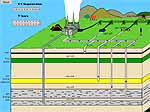|
|
Interactive Geologic
Sequestration Model |
|
|
 |
|
To view geologic sequestration
in action, click here to save the
executable file to your desktop
or run it from its location. Once
the model is displayed, select
the interactive choices in the
left-hand corner to display how
CO2 concentrations will change
over time. | | Carbon dioxide sequestration in geologic formations includes oil and gas reservoirs, unmineable coal seams, and deep saline reservoirs. These are structures that have stored crude oil, natural gas, brine and CO2 over millions of years. Many power plants and other large emitters of CO2 are located near geologic formations that are amenable to CO2 storage. Further, in many cases, injection of CO2 into a geologic formation can enhance the recovery of hydrocarbons, providing value-added byproducts that can offset the cost of CO2 capture and sequestration.
The primary goal of the Energy Department's sequestration research is to understand the behavior of CO2 when stored in geologic formations. For example, studies are being done to determine the extent to which the CO2 moves within the geologic formation, and what physical and chemical changes occur to the formation when CO2 is injected. This information is key to ensure that sequestration will not impair the geologic integrity of an underground formation and that CO2 storage is secure and environmentally acceptable.
Oil and Gas Reservoirs. In some cases, production from an oil or natural gas reservoir can be enhanced by pumping CO2 gas into the reservoir to push out the product, which is called enhanced oil recovery. The United States is the world leader in enhanced oil recovery technology, using about 32 million tons of CO2 per year for this purpose. From the perspective of the sequestration program, enhanced oil recovery represents an opportunity to sequester carbon at low net cost, due to the revenues from recovered oil/gas.
In an enhanced oil recovery application, the integrity of the CO2 that remains in the reservoir is well-understood and very high, as long as the original pressure of the reservoir is not exceeded. The scope of this EOR application is currently economically limited to point sources of CO2 emissions that are near an oil or natural gas reservoir.
Coal Bed Methane. Coal beds typically contain large amounts of methane-rich gas that is adsorbed onto the surface of the coal. The current practice for recovering coal bed methane is to depressurize the bed, usually by pumping water out of the reservoir. An alternative approach is to inject carbon dioxide gas into the bed. Tests have shown that the adsorption rate for CO2 to be approximately twice that of methane, giving it the potential to efficiently displace methane and remain sequestered in the bed. CO2 recovery of coal bed methane has been demonstrated in limited field tests, but much more work is necessary to understand and optimize the process.
Similar to the by-product value gained from enhanced oil recovery, the recovered methane provides a value-added revenue stream to the carbon sequestration process, creating a low net cost option. The U.S. coal resources are estimated at 6 trillion tons, and 90 percent of it is currently unmineable due to seam thickness, depth, and structural integrity. Another promising aspect of CO2 sequestration in coal beds is that many of the large unmineable coal seams are near electricity generating facilities that can be large point sources of CO2 gas. Thus, limited pipeline transport of CO2 gas would be required. Integration of coal bed methane with a coal-fired electricity generating system can provide an option for additional power generation with low emissions.
Saline Formations. Sequestration of CO2 in deep saline formations does not produce value-added by-products, but it has other advantages. First, the estimated carbon storage capacity of saline formations in the United States is large, making them a viable long-term solution. It has been estimated that deep saline formations in the United States could potentially store up to 500 billion tonnes of CO2.
Second, most existing large CO2 point sources are within easy access to a saline formation injection point, and therefore sequestration in saline formations is compatible with a strategy of transforming large portions of the existing U.S. energy and industrial assets to near-zero carbon emissions via low-cost carbon sequestration retrofits.
Assuring the environmental acceptability and safety of CO2 storage in saline formations is a key component of this program element. Determining that CO2 will not escape from formations and either migrate up to the earth?s surface or contaminate drinking water supplies is a key aspect of sequestration research. Although much work is needed to better understand and characterize sequestration of CO2 in deep saline formations, a significant baseline of information and experience exists. For example, as part of enhanced oil recovery operations, the oil industry routinely injects brines from the recovered oil into saline reservoirs, and the U.S. Environmental Protection Agency (EPA) has permitted some hazardous waste disposal sites that inject liquid wastes into deep saline formations.
In addition, the Norwegian oil company, Statoil, is injecting approximately one million tonnes per year of recovered CO2 into the Utsira Sand, a saline formation under the sea associated with the Sleipner West Heimdel gas reservoir. The amount being sequestered is equivalent to the output of a 150-megawatt coal-fired power plant.
|
 |
 |
 |
PROJECT INFO
 |
PROGRAM CONTACTS
 |
> |
Sean Plasynski
National Energy Technology Laboratory
P.O. Box 10940
U.S. Department of Energy
Pittsburgh, PA 15236
412-386-4867 |

|
> |
Darian Ghorbi
Office of Fossil Energy
(FE-26)
U.S. Department of Energy
Washington, DC 20585
202-586-4927 |

|
> |
Robert Kane
Office of Fossil Energy
(FE-26)
U.S. Dept. of Energy
Washington, DC 20585
202-586-4753 |

|
|